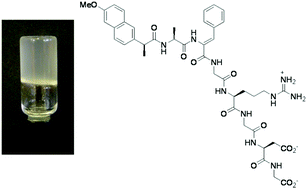当前位置:
X-MOL 学术
›
J. Mater. Chem. B
›
论文详情
Our official English website, www.x-mol.net, welcomes your feedback! (Note: you will need to create a separate account there.)
Self-assembled RGD dehydropeptide hydrogels for drug delivery applications
Journal of Materials Chemistry B ( IF 7 ) Pub Date : 2017-10-27 00:00:00 , DOI: 10.1039/c7tb01883e Helena Vilaça 1, 2, 3, 4 , Tarsila Castro 1, 2, 3, 4, 5 , Fernando M. G. Costa 2, 3, 4, 6 , Manuel Melle-Franco 2, 3, 4, 5, 7 , Loic Hilliou 2, 4, 8, 9, 10 , Ian W. Hamley 11, 12, 13, 14 , Elisabete M. S. Castanheira 2, 3, 4, 6 , José A. Martins 1, 2, 3, 4 , Paula M. T. Ferreira 1, 2, 3, 4
Journal of Materials Chemistry B ( IF 7 ) Pub Date : 2017-10-27 00:00:00 , DOI: 10.1039/c7tb01883e Helena Vilaça 1, 2, 3, 4 , Tarsila Castro 1, 2, 3, 4, 5 , Fernando M. G. Costa 2, 3, 4, 6 , Manuel Melle-Franco 2, 3, 4, 5, 7 , Loic Hilliou 2, 4, 8, 9, 10 , Ian W. Hamley 11, 12, 13, 14 , Elisabete M. S. Castanheira 2, 3, 4, 6 , José A. Martins 1, 2, 3, 4 , Paula M. T. Ferreira 1, 2, 3, 4
Affiliation

|
Peptide-based self-assembled hydrogels have triggered remarkable research interest in recent years owing to their biocompatibility and biomimetic properties and responsiveness, which warrant many technological and biomedical applications. Dehydrodipeptides N-capped with naproxen emerged from our research as effective hydrogelators endowed with resistance to proteolysis. Dehydrodipeptide-based hydrogels are promising nanocarriers for drug delivery applications. In this work, we demonstrate that dehydrodipetide Npx-L-Ala-Z-ΔPhe-OH can be deployed as a minimalist hydrogelator module for synthesizing a gelating construct Npx-L-Ala-Z-ΔPhe-G-R-G-D-G-OH bearing a GRGDG adhesion motif. The self-assembly of the peptide construct and the drug delivery properties of the hydrogel were studied in this work. The peptide construct showed no toxicity towards a fibroblast cell line expressing the αvβ3 integrin. Docking studies suggest that the hydrogelator block does not interfere with the recognition of the RGD motif by the integrin receptor. The self-assembly seems to be directed by intermolecular naphthalene π–π stacking interactions, with the peptide backbone assuming a random coil conformation both in solution and in the gel phase. TEM and STEM imaging revealed that the hydrogel is made of entangled bundles of long thin fibres (width circa 23 nm). The hydrogel exhibits viscoelastic properties, thermo-reversibility and recovery after mechanical fluidization. FRET studies showed that curcumin incorporated into the hydrogel interacts non-covalently with the hydrogel fibrils. Delivery of curcumin from the hydrogel into Nile red loaded model membranes (SUVs) was demonstrated by FRET. Naproxen N-capped dehydrodipeptides are efficacious minimalist hydrogelator modules for obtaining hydrogels functionalized with peptide ligands for cell receptors. These hydrogels are potential nanocarriers for drug delivery.
中文翻译:

自组装的RGD脱氢肽水凝胶用于药物输送应用
基于肽的自组装水凝胶由于其生物相容性,仿生特性和响应性而在近年来引起了巨大的研究兴趣,这保证了许多技术和生物医学应用。N峰覆盖了萘普生的脱氢二肽是我们的研究成果,因为它具有对蛋白水解具有抵抗力的有效水凝胶化剂。基于脱氢二肽的水凝胶是用于药物递送应用的有前途的纳米载体。在这项工作中,我们证明了脱氢双肽Npx- L -Ala - Z -ΔPhe-OH可作为用于合成胶凝构建体Npx- L -Ala- Z的极简水凝胶器模块。带有GRGDG附着基序的-ΔPhe-GRGDG-OH。在这项工作中研究了肽构建体的自组装和水凝胶的药物传递特性。的肽构建表明朝向表达α成纤维细胞系没有毒性v β 3整联蛋白。对接研究表明,水凝胶阻滞剂不会干扰整联蛋白受体对RGD基序的识别。自组装似乎是由分子间萘π-π堆积相互作用指导的,而肽主链在溶液和凝胶相中均假定为无规卷曲构象。TEM和STEM成像表明水凝胶是由缠结的长细纤维束构成的(宽度约23 nm)。水凝胶在机械流化后表现出粘弹性,热可逆性和恢复性。FRET研究表明,并入水凝胶的姜黄素与水凝胶原纤维非共价相互作用。FRET证明了姜黄素从水凝胶到尼罗红加载模型膜(SUVs)的传递。萘普生N封端的脱氢二肽是有效的极简水凝胶模块,可用于获得被细胞受体肽配体官能化的水凝胶。这些水凝胶是潜在的用于药物递送的纳米载体。
更新日期:2017-11-08
中文翻译:

自组装的RGD脱氢肽水凝胶用于药物输送应用
基于肽的自组装水凝胶由于其生物相容性,仿生特性和响应性而在近年来引起了巨大的研究兴趣,这保证了许多技术和生物医学应用。N峰覆盖了萘普生的脱氢二肽是我们的研究成果,因为它具有对蛋白水解具有抵抗力的有效水凝胶化剂。基于脱氢二肽的水凝胶是用于药物递送应用的有前途的纳米载体。在这项工作中,我们证明了脱氢双肽Npx- L -Ala - Z -ΔPhe-OH可作为用于合成胶凝构建体Npx- L -Ala- Z的极简水凝胶器模块。带有GRGDG附着基序的-ΔPhe-GRGDG-OH。在这项工作中研究了肽构建体的自组装和水凝胶的药物传递特性。的肽构建表明朝向表达α成纤维细胞系没有毒性v β 3整联蛋白。对接研究表明,水凝胶阻滞剂不会干扰整联蛋白受体对RGD基序的识别。自组装似乎是由分子间萘π-π堆积相互作用指导的,而肽主链在溶液和凝胶相中均假定为无规卷曲构象。TEM和STEM成像表明水凝胶是由缠结的长细纤维束构成的(宽度约23 nm)。水凝胶在机械流化后表现出粘弹性,热可逆性和恢复性。FRET研究表明,并入水凝胶的姜黄素与水凝胶原纤维非共价相互作用。FRET证明了姜黄素从水凝胶到尼罗红加载模型膜(SUVs)的传递。萘普生N封端的脱氢二肽是有效的极简水凝胶模块,可用于获得被细胞受体肽配体官能化的水凝胶。这些水凝胶是潜在的用于药物递送的纳米载体。


























 京公网安备 11010802027423号
京公网安备 11010802027423号